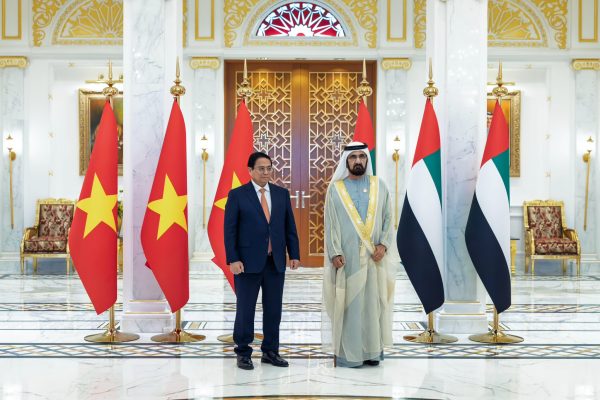The United Arab Emirates and Vietnam yesterday signed a comprehensive economic partnership agreement, the first free trade agreement that Hanoi has established with a Middle East country.
According to a statement from Vietnam’s Ministry of Industry and Trade, the Vietnam-UAE Comprehensive Economic Partnership Agreement was signed by Prime Minister Pham Minh Chinh and UAE Prime Minister Mohammed bin Rashid Al Maktoum in Dubai yesterday. State media reported that Vietnamese Minister of Industry and Trade Nguyen Hong Dien and UAE Minister of State for Foreign Trade Thani bin Ahmed Al Zeyoudi were also present at the signing.
As the Ministry put it, the signing of the agreement, which followed a year of negotiations, opened “a new era in the upgraded and increasingly substantive relationship between Vietnam and the UAE in particular and Arab countries in general.” The UAE is currently Vietnam’s largest export market in the Middle East, and its second-largest trading partner, after Kuwait.
Under the terms of the CEPA, the UAE has committed to phasing out tariffs on 99 percent of Vietnam’s exports, which include a mix of manufactured goods including textiles and footwear, mobile phones, computers, computer components, and household electronics, and agricultural goods such as pepper and seafood. At the same time, Vietnam has pledged to remove tariffs on 98.5 percent of the UAE’s exports, which mostly include liquefied petroleum gas (LPG), petroleum products, animal feed ingredients, base metals, and chemicals.
The Ministry said that the economic and trade structures of the two countries are “complementary” and that the agreement was a “clear demonstration of the commitment to bring trade and investment cooperation between the two sides to a new level.”
The scope of the economic interaction between Vietnam and the UAE is modest; last year, two-way trade between the two countries came to around $4.7 billion, an increase of 6 percent over 2022, according to the Ministry of Trade and Industry. However, the CEPA is perhaps more significant for what it says about Vietnam’s proactive approach to foreign relations.
Over the past few years, the country has intensified the pace of its diversified and omnidirectional foreign policy, making attempts to broaden and deepen its relationships with important regional and global powers. Over the past two years, it has elevated relations with South Korea, the United States, Japan, Australia, and France to the level of the Comprehensive Strategic Partnership (CSP), the highest tier in its diplomatic hierarchy. It also has CSPs with China (established in 2008), Russia (2012), and India (2016).
In this context, any improvement in Vietnam’s modest relations with the Middle East will provide an additional strengthening strand to its diversified foreign policy.


